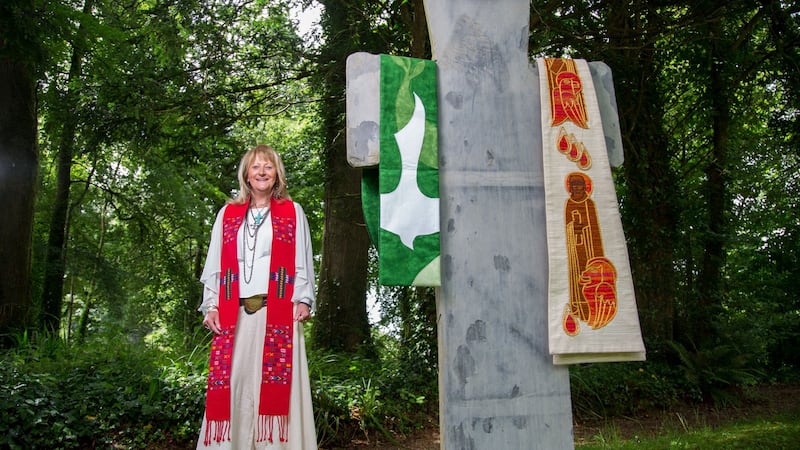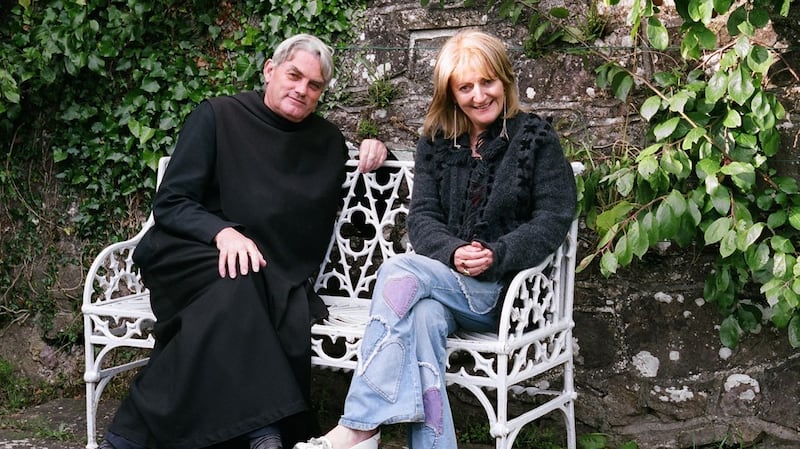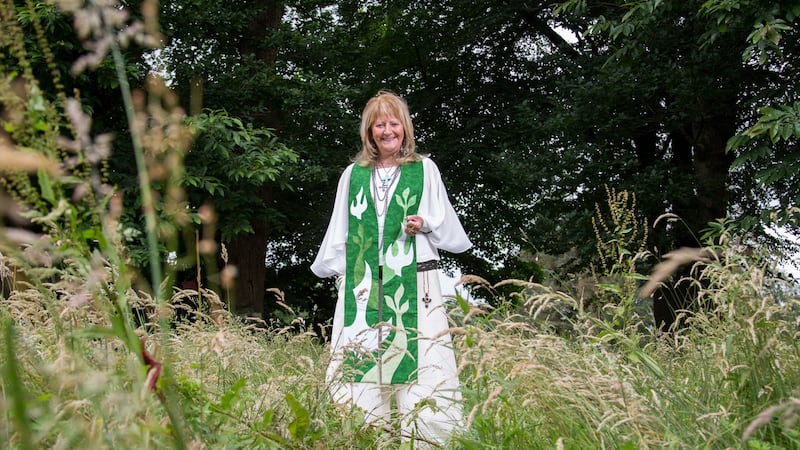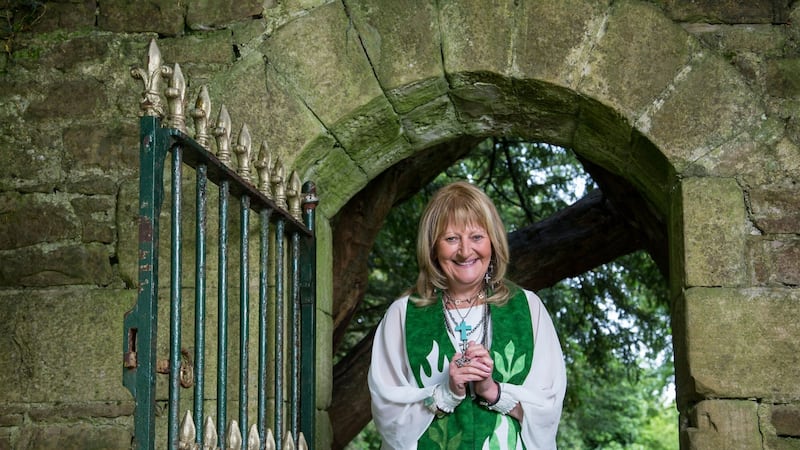Nóirín Ní Riain was seven years old when her heart was broken for the first time. “I can see it clearly. I came out on the landing with the bay window, looking out on the old tree and said to my brother Noel: ‘I want to be a priest.’” His answer took her childhood world from under her. “A priest? You can’t even be an altar boy.”
The feeling is still raw. But this is neither look back in anger or emotion recollected in tranquillity. This is the story of a woman who desperately wanted to be a priest in a world which said “No”.
It is the story of a woman transcending the oppressions of Catholicism to follow her vocation.

“Every religion has its dark side,” she says, “but the golden rule is the essence of all: do unto others as you would that they should do to you.” When the Dalai Lama gave her a copy of the rule in the eight great religions, he said: “Love thy neighbour as thyself..... Poor neighbour!”
The terrible heartbreak was a hard start to “loving thyself”. But this is the thread of her story; this and the relationship with Glenstal Abbey.
We stand at the beautiful Garran Bán (Silver Grove), by the little house which Nóirín can finally call a home of her own. “This is the boundary of Glenstal,” she says, pointing to the monastery in the green near distance. “And I’m on the edge of it.” It is a fitting analogy for one who, one way or another, has lived on the edge since that fateful moment on the landing.
However, this homecoming is not merely literal. In two weeks’ time on July 29th, Dr Nóirín Ní Riain – author, lecturer in theology, world-renowned singer whose name is synonymous with the Monks of Glenstal – will be ordained as the Rev Nóirín Ní Riain, minster in the One Spirit Inter Faith Seminary Foundation.
Religious rituals
She will not, as was her wont in her bedroom all those years ago, be saying Mass, but she will be doing wedding ceremonies and other religious rituals and rites of passage, plus one ritual of her very own: she intends to perform special blessings for divorcing couples. That she is uniquely placed to do so is evident from the events of this month. On July 15th she will attend the marriage blessing of her ex-husband, composer Micheál Ó Súilleabháin to Helen Phelan and two weeks later, Ó Súilleabháin will attend her ordination.
If all this seems like a stunning symmetry, you just have to consider that the dramatis personae are artists and all neatness fades on the instant. Life is never simple, but Ní Riain’s has been complicated and peripatetic, questing and courageous. And it still is. As with her accounts of the most momentous events in her life, you strain to catch the magnitude.
“I have stepped off the Catholicism boat and am stepping into a little dinghy,” she murmurs. There’s no minimising the shock: this woman of profound devotion, who for 16 years sang all the Offices – matins, eucharist, vespers and evening prayers – in a monastery, has had to step off the arc of Catholicism to fulfil her vocation.
But , as she takes the boldest step in her life, she is clear-eyed. “All I want is to do work through this ministry. It extends the theme of my book and my doctorate, listening with the ear of the heart. I love Christianity. It’s got spirituality.”
Obviously, from the time she eschewed dolls in favour of saying Mass, she has had a hunger for the spiritual. And the years of living in Glenstal fed that hunger in a way that opened her horizons. She sees it as a place apart, a place which has withstood the daily spites of an unmannerly church. “The church went down the wrong road. Belief became institutionalised. Glenstal is a beacon of light in the church.”
Refuge
It also became her refuge. As the embers died on the last century, divorced and determined to become a theologian, she found herself adrift. “They originally took me in so I could finish my doctorate. I spent 16 years in Glenstal. When I came here I had no possessions. All I had to hold on to was my relationship with God. They had great foresight to take me in. It went to a vote. They were very generous. It was highly innovative. The monks are my best friends.”

But of course, the monks and Nóirín were not strangers. "It goes back to the recordings," she says, referring to the famous Caoineadh na Maighne and Good People All (the musical collaborations between herself and the monks). She conjures up an image of a choral cloister. "It was genderless. The monastery is genderless." The music critic of The Irish Times, Charles Acton, saw it somewhat differently. He saw the glory of a Deanna Durbin against the ascetic monastery wall and knew it was a killer combination. If it took the music world by storm, for Nóirín it "copperfastened the connection with the monks".
I got on okay with Ó Ríada, but he was a man's man. When we'd go to Cúil Aodha he'd take the men in for poteen. And we women went into the kitchen with Ruth
She says “it was a lovely time”. But it was not the glamour or the adulation she valued; she was well used to being the golden girl. In fact, she and fellow music student Micheál Ó Súilleabháin were known as the golden couple in the great stone corridors of UCC, in the legendary Refectory where love stories began and in the glorious Music Room where their tutors, Aloys Fleischmann and Seán Ó Ríada, recognised that they were guardians of talents of celestial proportions.
Even back then, in the early 1970s, before feminism came to Ireland, she was sensitive to everyday segregations. “I got on okay with Ó Ríada, but he was a man’s man. When we’d go to Cúil Aodha he’d take the men in for poteen. And we women went into the kitchen with Ruth.”
Romance flourished. “Micheál and I were very bonded. Even then, I was always dragging people to the Honan Chapel. I’d arrange to meet people at 12 o’clock mass. Micheál accepted it all. There’s a deeply spiritual side to him. And he accepted the whole Glenstal thing.“
Preoccupation
He had little alternative. The fact is, her preoccupation with Glenstal long preceded the recordings. Indeed, it is as if the monastery manifested itself to protect her from the words that told her she was a lesser being in the eyes of the Church. She was seven when she discovered it. “My mother drove me over in her green Morris Minor. After that I’d cycle over, drop my bike and sit in the back of the church. I was alone a lot. My father was a businessman and my mother a teacher. So I became attached to the place. The very soil of Glenstal is special. Later on Mick and I came here.”
They moved in there in 1982, as a young family with a bouncing toddler, Eoin, for the duration of Micheál’s sabbatical. This was not entirely unusual: the monks had previously opened their hearts to the Ó Ríada children. But by 1982, the legend of Nóirín Ní Riain and the monks of Glenstal was well established.
“The idea of us singing together was osmosis. We were living in Cork, Mick was lecturing in UCC and I was doing a masters in religious songs in Irish. I had to learn all these songs. A little church in Caherline was opening and the monks were asked to sing and so was I. Then there was a nuns’ concert and we did that too.”
At these early concerts she met the monks who were to become her friends for life. “That was the first time I met Patrick, [Mark Patrick Hederman, later Abbott of Glenstal] and Ciaran.” Brother Ciaran Forbes, a renaissance man like many of the monks, has chosen wood turning for self expression.
It was Ciaran who, long before the Grattan Esmonde collection of Greek orthodox icons became one of the big attractions of Glenstal, used to press an icon on Nóirín, to allow her create a peripatetic altar while on tour. Years later she would have nightmares at the thought of the treasure at the bottom of her suitcase.
“Ciaran was the chanter – he did all the recording. He and Patrick loved the singing. The Abbott of the time was very into Muire [the Virgin Mary]. When Micheál and I were living in Peace Cottage there , he would invite us ‘down for tea’. We were there looking up at the monks and they were looking at a married couple.” It was clearly edifying for both.
Family
The birth of their second son Moley in 1984 completed the family and Nóirín and Micheál were rapidly attaining the status of music royalty. Their Georgian house in Dromore, a few miles from Glenstal, with its peacocks and llamas, must have struck their many artist and celebrity visitors as an arcadian dream. “I was happy there,” she says, but it wasn’t to last. “Our marriage was a long time breaking up. In the end, in August 1998, I jumped out of it. I went to Dublin.” Needless to mention, she had no plan. Or so she thought.

“In 1996 when I was on tour with Anam Cara founder John O’Donoghue, he had suggested I do a doctorate.” In 2001, having completed a qualifying masters and installed in Glenstal, she braved the University of Limerick theology department and said “I want to do a doctorate in theology.” After some initial shock, she was accepted and she became the first PhD in theology in UL. “I had to learn the academic language, which I hated. Then when I came to write an ordinary book I had to unlearn it all again.”
There wasn't anywhere else I wanted to go after the demise of Mick and myself
A doctorate, a book – clearly her creativity thrived in Glenstal. But taking her in was momentous for them too. Why did they do it? “They were really my friends. There wasn’t anywhere else I wanted to go after the demise of Mick and myself. And they would have known the difficulties we were going through.” But there was another factor, probably the leitmotif for the monks who made the decision to welcome her. “On top of everything, they identified with the belief that I had. The belief in the divine.”
So how do they feel about her impending ordination?
“The monks of Glenstal are not clerical and they are not institutional. They are autonomous.
“There are monks up there who were married, who are divorced. I remember sitting down in the pews with someone who was divorced and then the following day looking up and he was up there. One of them. And I could never be. Even though they are in touch with their feminine sides, I didn’t feel equal. They don’t actually realise how different it is if you’re a man. A glazed look comes over the eyes. Like when you say you are divorced. ”
Endowed with grace
The biggest change is in herself. “Something has happened to me with the decision to go for ordination. I feel that I am endowed with grace. I feel equal. I love the word ‘ordain’, it comes from order. There is a letter from St Peter which says ‘we are our own temples,’ so in Inter Faith we ordain ourselves. We do our own vows."
Ordination never figured in Christ’s trajectory, but that doesn’t stop the church from fetishising it as a male prerogative, nor clinging to Christ’s choosing of men as apostles to justify excluding women. Or the even more perverse way it cites the fact that he did not choose his mother as an apostle to show that he believed in a different order for women.
A breast cancer scare was the catalyst for the leap towards ordination. “My path was clear. Like Jung whose house motto at Keussnacht proclaimed ‘called or not called god is present,’ I was always looking for reasons to be talking about God, but still very much a Catholic, the religion of my parents.” Though now a Christian humanist whose love of Christianity is total, “It has the divine, the human and the holy spirit ,” she loves “all the little rituals of catholicism – the rosary, the stations of the cross, they are all mantras.”
By now “propelled into it”, she found what she was looking for: a two-year course. “But how was I going to manage it? London? Hammersmith? I don’t know it. My age. My finances. The first year was hard. The course was mainly looking at different faiths, which of course I knew from theology. But you also delved deep into the psyche. The second year was more interesting. They train you in what they call spiritual counselling. You’re not a qualified counsellor, but you can do blessings.”
There were new emotions.“For the first time I was on the other side of the desk. Humility coming out of a good space. I enjoyed that plethora of people you wouldn’t have met when you’re a performer. You bond very deeply.
But the church has ignored the role of the imagination even though the word literally means in the image of God
“And of course it deepened my whole theory of listening with the ear of the heart, which in turn is all about the imagination. Einstein said imagination was more important than knowledge, as it had no limits. But the church has ignored the role of the imagination even though the word literally means in the image of God.”
Divorce blessings
Her first triumph of imagination is the divorce blessings. “I hate the word divorce – it’s ugly. In the same way that two people came together they can come apart. It’s a formal way of saying, ‘this is God’s thing too’. The church regards divorce as a failure. I don’t. It has been a blessing in my life. I wouldn’t have done the doctorate. I wouldn’t be here talking about my ordination, if I hadn’t been divorced.”
But before the divorces, there will be weddings. The HSE formally recognises the One Spirit Inter Faith Seminary and recognises that marriages performed are legal. Couples don’t have to go to the Registry Office, except for the normal three months notice .

She repeatedly returns to the heartbreak on the landing. Not to wallow or berate, but to point out that there are two kinds of heartbreak: the one that shatters the heart and the one that splinters and lets the light in. She feels the light has been coming in all these years. To me, she feels more like a great survivor who has finally broken the silence. And her extraordinary life, wife, mother, monk manqué, all adds up to a powerful minister.
She paraphrases the great meditative poem of the Hopi Elders. We are the ones we have been waiting for.
“I am the one I’ve been waiting for,” she says.











